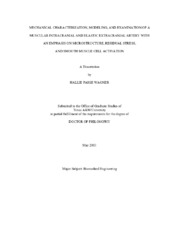| dc.contributor.advisor | Moore, James E. | |
| dc.creator | Wagner, Hallie | |
| dc.date.accessioned | 2012-07-16T15:56:50Z | |
| dc.date.accessioned | 2012-07-16T20:32:57Z | |
| dc.date.available | 2012-07-16T15:56:50Z | |
| dc.date.available | 2012-07-16T20:32:57Z | |
| dc.date.created | 2011-05 | |
| dc.date.issued | 2012-07-16 | |
| dc.date.submitted | May 2011 | |
| dc.identifier.uri | https://hdl.handle.net/1969.1/ETD-TAMU-2011-05-9239 | |
| dc.description.abstract | Cerebrovascular disease continues to be responsible for significant morbidity and mortality. There is a pressing need to better understand the biomechanics of both intracranial arteries and the extracranial arteries that feed these vessels. Histology and immunohistochemistry were performed on basilar and carotid arteries and elucidated their structural differences. Nonlinear optical microscopy (NLOM) provided collagen fiber orientation and distribution, which offered motivation for a more microstructrually-based model. Biaxial testing was performed on acute basilar and carotid arteries and cultured basilar arteries. We used a validated 2D, four fiber family constitutive relation to model passive biaxial stress-stretch behaviors of basilar and common carotid arteries, and we developed a new relation to model their active biaxial responses. Residual stress information from opening angles and collagen fiber orientation were used to create a 3D fiber distribution constitutive relation. Passive biaxial stress-stretch behavior of basilar arteries was modeled with the 3D fiber distribution constitutive relation and was combined with our new active relation to model the active response of basilar arteries.
These data and 2D, four fiber family and active constitutive relation allow the first full comparison of circumferential and axial biomechanical behaviors between a muscular (basilar) and an elastic (carotid) artery from the same species. Our active model describes the responses by both types of vessels to four doses of the vasoconstrictor endothelin-1 (10^-10, 10^-9, 10^-8, 10^-7 M) and predicts levels of smooth muscle activation associated with basal tone under specific in vitro testing conditions. Cultured arteries revealed smooth muscle tone is necessary for vascular remodeling. Our 3D model allowed for the calculation of stress through the wall in passive basilar arteries. These results advance our understanding of the biomechanics of intracranial and extracranial arteries, which is needed to understand better their differential responses to similar perturbations in hemodynamic loading. | en |
| dc.format.mimetype | application/pdf | |
| dc.language.iso | en_US | |
| dc.subject | basilar | en |
| dc.subject | carotid | en |
| dc.subject | artery | en |
| dc.subject | modeling | en |
| dc.subject | smooth muscle activation | en |
| dc.title | Mechanical characterization, modeling, and examination of a muscular intracranial and elastic extracranial artery with an emphasis on microstructure, residual stress, and smooth muscle cell activation | en |
| dc.type | Thesis | en |
| thesis.degree.department | Biomedical Engineering | en |
| thesis.degree.discipline | Biomedical Engineering | en |
| thesis.degree.grantor | Texas A&M University | en |
| thesis.degree.name | Doctor of Philosophy | en |
| thesis.degree.level | Doctoral | en |
| dc.contributor.committeeMember | Yeh, Alvin T. | |
| dc.contributor.committeeMember | Wilson, Emily | |
| dc.contributor.committeeMember | Maitland, Duncan J. | |
| dc.type.genre | thesis | en |
| dc.type.material | text | en |


